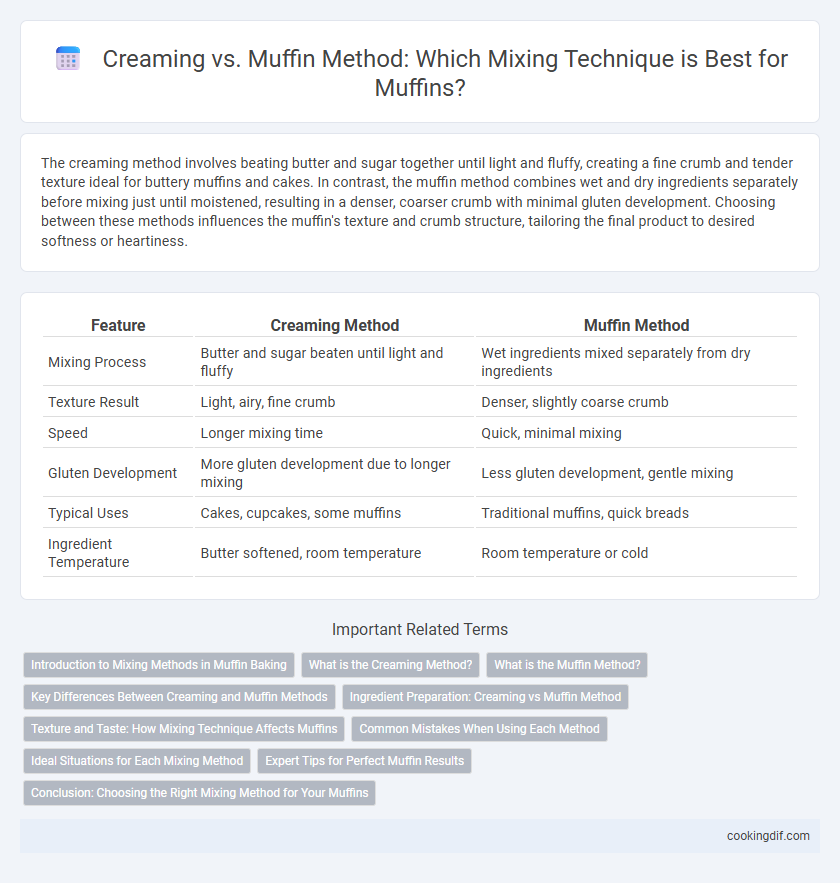The creaming method involves beating butter and sugar together until light and fluffy, creating a fine crumb and tender texture ideal for buttery muffins and cakes. In contrast, the muffin method combines wet and dry ingredients separately before mixing just until moistened, resulting in a denser, coarser crumb with minimal gluten development. Choosing between these methods influences the muffin's texture and crumb structure, tailoring the final product to desired softness or heartiness.
Table of Comparison
| Feature | Creaming Method | Muffin Method |
|---|---|---|
| Mixing Process | Butter and sugar beaten until light and fluffy | Wet ingredients mixed separately from dry ingredients |
| Texture Result | Light, airy, fine crumb | Denser, slightly coarse crumb |
| Speed | Longer mixing time | Quick, minimal mixing |
| Gluten Development | More gluten development due to longer mixing | Less gluten development, gentle mixing |
| Typical Uses | Cakes, cupcakes, some muffins | Traditional muffins, quick breads |
| Ingredient Temperature | Butter softened, room temperature | Room temperature or cold |
Introduction to Mixing Methods in Muffin Baking
The creaming method combines butter and sugar until light and fluffy, creating a fine crumb texture ideal for tender muffins. In contrast, the muffin method involves mixing wet and dry ingredients separately before combining them, yielding a denser, coarser crumb with minimal mixing to prevent gluten overdevelopment. Choosing the appropriate mixing technique directly influences muffin structure, moisture, and overall texture.
What is the Creaming Method?
The creaming method involves beating butter and sugar together until light and fluffy, incorporating air to create a tender and airy muffin texture. This technique improves leavening by trapping air bubbles, which expand during baking, resulting in a softer crumb. Properly creamed mixtures ensure even distribution of ingredients, enhancing the muffin's rise and moisture retention.
What is the Muffin Method?
The muffin method involves combining dry ingredients and wet ingredients separately before gently mixing them together just until moistened, which helps maintain a tender crumb. This technique prevents overmixing, reducing the development of gluten that can cause toughness in the final baked product. It is commonly used for muffins, quick breads, and pancakes to achieve a light, moist texture.
Key Differences Between Creaming and Muffin Methods
The creaming method involves beating butter and sugar together until light and fluffy, creating a stable air structure that yields a tender, fine crumb in muffins. In contrast, the muffin method combines wet and dry ingredients separately before gently mixing them to avoid overdeveloping gluten, resulting in a denser, coarser texture. Understanding these distinctions helps bakers control muffin texture and moisture for desired outcomes.
Ingredient Preparation: Creaming vs Muffin Method
The creaming method involves beating butter and sugar together until light and fluffy, creating a smooth texture that incorporates air for a tender crumb. In contrast, the muffin method mixes wet and dry ingredients separately before gently combining them to avoid overworking the batter, resulting in a denser, more tender muffin. Proper ingredient preparation in the creaming method requires softened butter for optimal aeration, while the muffin method emphasizes minimal mixing to maintain a tender crumb.
Texture and Taste: How Mixing Technique Affects Muffins
The creaming method produces muffins with a finer crumb and tender texture due to the incorporation of air when beating butter and sugar, enhancing lightness and flavor. In contrast, the muffin method blends wet and dry ingredients separately before combining, resulting in a denser, more moist crumb with a slightly coarser texture. Texture differences significantly influence taste perception, where creamed muffins offer a fluffier bite while muffins made with the muffin method provide a heartier, more substantial mouthfeel.
Common Mistakes When Using Each Method
Common mistakes in the creaming method include overbeating the butter and sugar, which can cause the batter to become dense and tough due to excess air incorporation. In the muffin method, overmixing the wet and dry ingredients leads to gluten development, resulting in tough, chewy muffins with tunnel-like holes. Both methods require careful attention to mixing times to ensure a tender crumb and proper rise.
Ideal Situations for Each Mixing Method
The creaming method is ideal for recipes requiring a light and airy texture, such as butter-based cakes and muffins with a fine crumb, as it incorporates air by beating butter and sugar together. The muffin method suits quick breads and muffins with a coarser texture, where wet and dry ingredients are mixed separately and combined just enough to avoid gluten overdevelopment. Selecting the proper mixing technique depends on the desired crumb structure and ingredient composition for optimal baking results.
Expert Tips for Perfect Muffin Results
For perfect muffin results, the creaming method involves beating butter and sugar until light and fluffy, creating a tender crumb with a more cake-like texture. The muffin method requires minimal mixing of wet and dry ingredients to avoid gluten development, producing a denser, coarser crumb typical of traditional muffins. Experts recommend using the muffin method for classic, moist muffins while reserving creaming for lighter, sweeter variations to balance texture and flavor.
Conclusion: Choosing the Right Mixing Method for Your Muffins
Selecting the right mixing method for muffins depends on the desired texture and crumb structure; the muffin method creates tender, moist muffins by gently combining wet and dry ingredients, minimizing gluten development. Creaming, which involves beating butter and sugar until fluffy, produces a lighter, cake-like crumb ideal for richer, more structured muffins. Bakers seeking ease and moistness typically favor the muffin method, while those aiming for a fine crumb and aeration prefer the creaming technique.
Creaming vs Muffin Method for mixing Infographic

 cookingdif.com
cookingdif.com